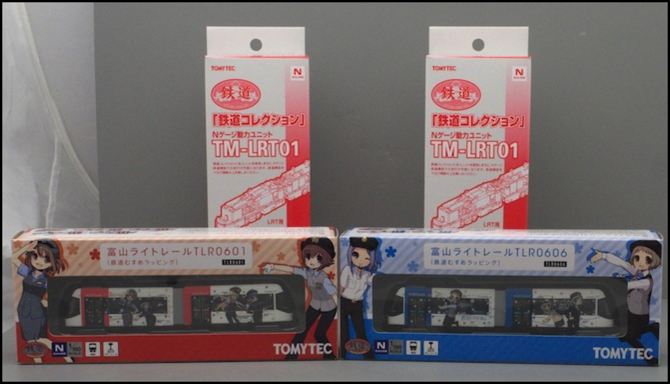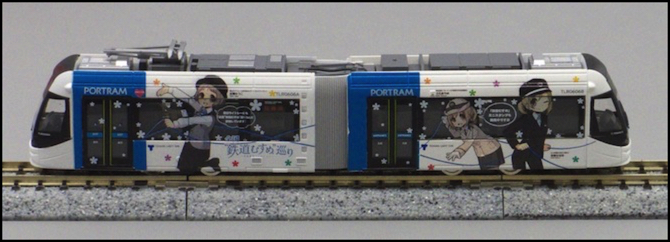Two Trams

A “tram” is a light rail vehicle. The word is British English; American’s still say “trolley” even though our light rail systems haven’t used trolley poles in decades. But it’s a word also used by the Japanese (who often borrow foreign words, either for marketing reasons or just because they like the sound).
The Toyama Light Rail line (Japanese Wikipedia), a company jointly owned by the Toyama city government and some other investors, operates light rail vehicles over a former freight railway running between the city center and the waterfront. This is officially known as the Toyamakō Line, but the locals know it as “Portram” (for Port Tram), and the vehicles introduced in 2006 have come to be known by that name. There are seven of them, all of basically the same design but in different colors. A separate railway operates a city-center ring using similar vehicles, known as the Centram (“Central Tram”, I presume).
Tomytec, the parent company of Tomix, has been making models of these as part of their Railway Collection series since about 2009. These are intended to be collectibles for display, and they’re just empty shells. They cost around US$15 - US$20. But Tomytec also makes a motor unit that replaces the underbody, the TM-LRT01, which goes for around US$30. So for under $50, you can have an operating model. They’re not as nice as Kato’s Portram models, which sell for about US$85 in Japan, but they’re still quite good models.
I had been thinking about getting one of these, just to see how they compared with the Portram (I have one of Kato’s Centram models), but hadn’t gotten around to it. Then, while I was wondering what I’d run on my One Point Five Meter Line layout, I saw this new pair of them and decided that a model tram with a replaceable motor was the perfect thing for a layout that may do a lot of running back and forth. I ordered the pair, and two of the motors (thankfully those were available; they often sell out and can’t be found for months on end).
I’ve put larger versions of these photos, plus some others, in the Roster Photo Album.
Tram vs Tram
My new Tomytec trams arrived this morning. So, how do they look, and operate, and how do they compare to Kato’s model? Sounds like it’s time for a review.
Kato Centram
Kato’s model that I have is actually a Centram, from the sister line, but aside from being a simple white in color, they’re the same vehicle. Both lines use low platforms or street stops, and both use 600V DC power.
Kato’s models are lit, both inside and with working head and tail lights, and have a detailed semi-interior, with a filler that comes up to the bottom of the windows. They use tiny motors that fit in the wheel assemblies The only real negative is that the pantograph is molded in plastic rather than being metal, but that’s a minor nit and it is well molded and can be raised with a finger-tip, and will remain in position. They run well, and fairly quietly. The printing is clean and crisp, and true to photos I’ve seen of the originals.

Kato 14-802-1 Toyama Chiho Centram, White
Tomytec Portram
Tomytec’s model is very similar to Kato’s. The body detail may be just a hair larger than Kato’s, but from any normal viewing distance you won’t notice that. The printing is both accurate and crisp. The pantograph is also plastic, and a bit cruder than Kato’s, but looks fairly good and similarly can be raised with a fingertip and will remain that way.
The specific ones I bought reflect an advertising wrap applied to the Portams for the month of September, 2013 (although apparently it was applied sometime in August). This features images of the Tetsudō Musume, or Railway Daughters. If you google “鉄道娘 富山” (Toyama Railway Daughter), you’ll turn up some youtube videos of the real ones in operation. You can also see photos of the those here.
The “Railway Daughters” is a Tomytec product line featuring wide-eyed manga-style young women in railway uniforms (the word translated as “daughters” can also mean “young women”), who are supposed to be railway employees in various jobs. There’s a stunning amount of collectible goods related to them (I have a couple of cargo containers for my container flat cars featuring Tetsudō Musume characters).
So what we have here are models of prototype trams advertising the product line that contains the models. Only in Japan can you find that kind of corporate entanglement between two unrelated companies.
But the goal of my one point five meter line is to be visually eye-catching, and I think manga-style characters on a modern light rail vehicle are likely to achieve that goal, which is one reason I picked out this pair.

Tomytec Toyama Portram, Blue, with Tetsudō Musume wrap
Unlike the Kato model, there’s no lighting and the motor unit fills the interior, so the nice molded seats that come with the display version have to be removed when it is motorized. The exterior detail is very similar to Kato’s, perhaps slightly less detailed on the roof, and the ribbing on the central pivot section is finer
Installing the motor is trivial. The body is in two parts, each clipped lightly to the underframe in four places. The underframe is also two sections, but they’re attached to each other with a screw at the joint. Simple spread the body at one end, and use the weight of the other end to pry the underframe away from the body until it drops out, then repeat for the other half. The two body shell halves then snap onto the motor. Be sure you press them all the way down though. I thought I did, and only later realized the red body had one end about 1 mm higher than it should have been.
Operation
The Kato model has smaller wheels and rides lower, making it look more like the prototype in operation (which appears to glide over the road). The Tomytec model rides higher, on wheels that are larger, with “pizza cutter” flanges. Both models have electrical pickup and motors on both trucks. And electrically, both run well and are quiet.

Tomytec - underside

Kato Underside

Tomytec TM-LRT01 Motor Unit, showing flywheel (center) and electrical pickups leading to motor from both ends
However, the low-riding of the Kato model is actually a problem, if your track isn’t perfect. Mine would bind running through an ordinary Unitrack crossover, and would derail one end at several different places on my Express Line track where it wasn’t perfectly in alignment. Although I was able to run it on a short test-track loop, I couldn’t get it to make a full circuit of my big layout.
The Tomytec model, by comparison, ran flawlessly. I ran each in loops around the Express Line for twenty minutes to break them in, and had no problems.
For a speed test, I ran all three trams up the long grade on my Express Line. This is a 2% grade that runs for 1.7m (a bit under six feet). With the Kato power pack set to 50%, I timed each three times and averaged them. The two Tomytec trams ran at a scale 220 - 230 kph (~142 mph), which is rather a bit too fast for a light rail vehicle. The Kato at the same throttle ran at a scale 58 kph, which is about the prototype’s maximum (60 kph is allowed on the non-street portions of its line, elsewhere it’s limited to 40 kph).
Despite that, the Tomytec trams ran quite smoothly at low throttle settings, no doubt helped by the flywheel and all-wheel electrical pickup, so they should look quite good running at realistic speeds.
Now I may just have a defective model, but it seems that the Kato version is very sensitive to track problems (note: there was a known problem with some early Kato trams sagging in the middle; mine does not have that problem).
Summary
The Kato model is a beautiful one, and on good track it looks superb in operation, although the lighted interior cries out for figures of passengers to be installed. But mine at least proved very problematic.
The Tomytec model doesn’t look as good, with no head or tail lights. And it rides visibly higher, enough that you can see the wheels from a low angle, which doesn’t look at all like the prototype. But aside from that it runs reliably and smoothly, and is a good-looking model. And it costs about 40% less than the Kato model even after you buy the motor.
I’m certainly satisfied that I made the right choice in buying this pair for the layout.



